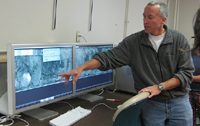Visualization for Geoscientists
October 8th, 2007
Categories: Applications, Government, Software, Visualization, VR

About
Apple :: Science :: Profiles
The Electronic Visualization Laboratory at the University of Illinois at Chicago has been the source of many widely used visualization tools, including the well-known CAVE environment.
Corewall, a software / hardware solution developed under an NSF grant, enables geoscientists to store and view images of scanned cores at high resolutions.
Co-principal EVL investigators Andy Johnson and Luc Renambot, working with graduate students James Lee and Julian Yu-Chung Chen, combined Mac workstations and Apple Cinema displays with Corewall’s Corelyzer core analysis software to provide tiled, high-resolution viewing platforms.
“The introduction of the 30-inch Apple Cinema Displays made creating tiled displays with fewer screens much easier,” says Jason Leigh, Director of EVL. “It’s great to have so much aggregate resolution on one big display. The standard Corewall configuration is now two 30-inch Apple Cinema Displays with 8 megapixels of resolution.”
Other software in the Corewall suite, developed at other institutions under the same NSF grant, provide a database for the storage of annotation data, a browser for locating cores of interest at websites worldwide, and a system for the geographic correlation of cores drilled in proximity to each other.
The CoreWall project development team includes researchers from the Lacustrine Core Repository at the University of Minnesota, the Borehole Research Group at Lamont-Doherty Earth Observatory of Columbia University, and INSTAAR at the University of Colorado.